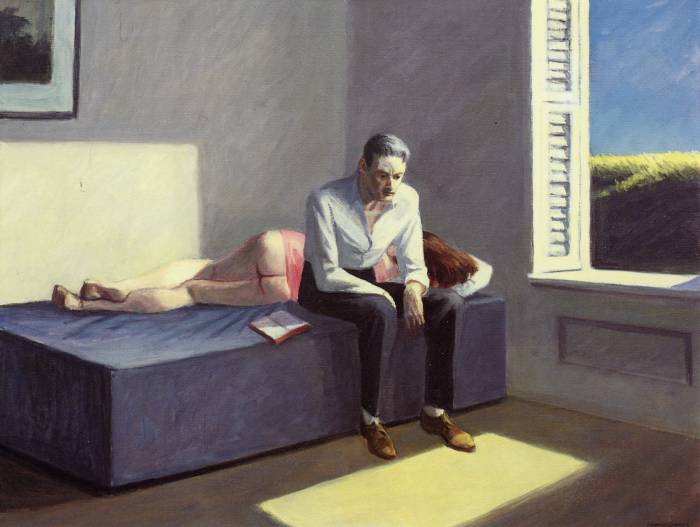
Excursion Into Philosophy
Edward Hopper, 1959

Excursion Into Philosophy
Edward Hopper, 1959
Light continues to fascinate Hopper in the paintings he made during the last fifteen years of this life. From Cape Cod Morning (1950) to Seawatchers and Morning Sun (1952) to Sunlight in Cafeteria (1958), Excursion into Philosophy (1959), Second Story Sunlight (1960), People in the Sun (1960), A Woman in the Sun (1961), and finally Sun in an Empty Room (1963), Hopper concerns himself with people who sit, stand, and wait in full sunlight or in rooms where abstract shapes of light are as visible on the walls as on the floors. In his later years Hopper regarded light as an important element that at times becomes a prosaic form of spirituality (the sunworshippers in People in the Sun) and sexuality (the story of the Christian Annunciation or the Greco-Roman tale of Zeus appearing to Danae in a ray of gold coins that seems to inform High Noon, Morning Sun, and A Woman in the Sun).
Excursion into Philosophy suggests still another approach to light. In the ledgers, Jo [Hopper’s wife] recorded cryptically, “The open book is Plato, re-read too late,” leaving one to consider the dilemma puzzling this man who stares into an almost abstract patch of light on the floor. The woman beside him seems to be a modern, young, and very sexy muse as well as the man’s lover. And the reference to Plato makes one wonder if the man is contemplating the meaning of reality and abstraction, which was certainly important to Hopper, who by the 1950s had been subjected to many statements by abstract artists about the role light played in their work. Since Plato praised the realm of ideas as the ultimate form of reality and relegated physical manifestations of them to a lower realm, the man in the painting seems to be questioning the idea of light versus an actual beam of it and the idea of beauty versus the presence of the voluptuous female on the bed beside him. One wonders if Hopper has attempted to condense the question of light, which occurs in so many of his works, into the Platonic argument. In his story about Socrates and the cave, Plato compares works of art to the shadows cast by ordinary objects that in themselves are only pale reflections of the true reality which is the realm of ideas. And in Excursion into Philosophy Hopper counters Plato’s mere shadows with a block of light which pictures itself and which symbolizes the potential of understanding (illumination).
—from Edward Hopper, by Robert Hobbs